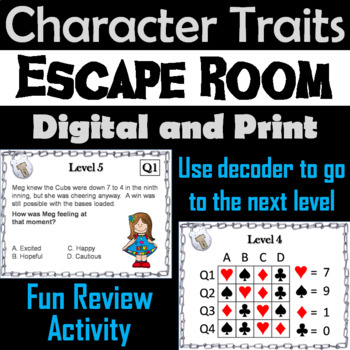Character Traits Passages Activity: Escape Room Reading Comprehension Strategies
- PDF
What educators are saying
Also included in
- This bundle includes all of the escape rooms listed below. Important: (How to Make Completely Digital)This product normally requires the printing of the questions to accompany a digital form for students to input answers. But if you follow a couple simple steps, this can be made entirely digital!Price $58.50Original Price $90.00Save $31.50
Description
This breakout escape room is a fun way for students to test their skills with character traits. Given short passages, students must identify the character trait that best describes the character in the passage. Students then use decoder puzzles to turn their answers into a 4 digit code to break out of the game.
Full "Letter" sized cards as well as smaller sized cards are provided.
Important: (How to Make Completely Digital)
This product normally requires the printing of the questions to accompany a digital form for students to input answers. But if you follow a couple simple steps, this can be made entirely digital! Just use the following tool:
https://smallpdf.com/split-pdf
(choose "extract pages")
to extract the pages containing the questions into its own PDF. You can then upload that PDF to your Google Classroom, or something similar, so that the students can view the puzzles online.
This escape room then becomes completely digital!
Important: Please view the Video Preview (found within the thumbnails above) for an explanation on how to decode the levels.
Contents:
♦ Teacher Instructions with Usage Guide and FAQ
♦ 20 Multiple Choice Questions
♦ 5 Decoders for each of the 5 Levels
♦ Student Recording Sheet and Teacher Answer Key
♦ Large Sized Cards and Smaller
♦ Link to an optional, but recommended, digital breakout room
Check out the preview for more details!
More Escape Rooms:
All the following topics can be found in the Ultimate ELA Escape Room Bundle (60% OFF!)
Reading Comprehension: Get all 15 (35% OFF) in the Bundle!
♦ Genres
♦ Idioms
♦ Informational Text Structures
♦ Setting
♦ Similes
♦ Theme
Vocabulary: Get all 10 (35% OFF) in the Bundle!
♦ Analogies - 3rd Grade (not in bundle)
♦ Analogies - 4th Grade (not in bundle)
♦ Analogies - 5th Grade (not in bundle)
♦ Analogies - 6th Grade (not in bundle)
♦ Analogies - 7th Grade (not in bundle)
♦ Analogies - 8th Grade (not in bundle)
♦ Analogies - 9th Grade (not in bundle)
♦ Antonyms
♦ Prefixes
♦ Suffixes
♦ Synonyms
Grammar: Get all 13 (35% OFF) in the Bundle!
♦ Adverbs
♦ Commas
♦ Pronoun Antecedent Agreement
♦ Verbs






